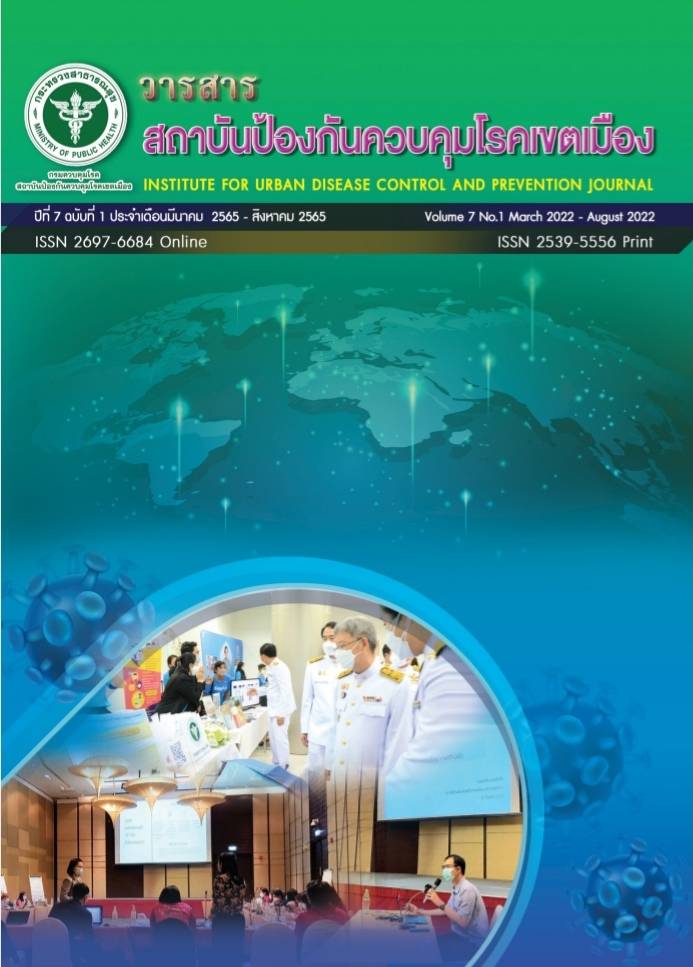การพัฒนาแอปพลิเคชันบนสมาร์ทโฟนเพื่อการสื่อสารการป้องกันควบคุมโรคไข้เลือดออก สำหรับนักเรียนชั้นประถมศึกษาปีที่ 4-6 ในพื้นที่เขตเทศบาลนครนครศรีธรรมราช
Main Article Content
บทคัดย่อ
การศึกษานี้มีวัตถุประสงค์เพื่อ (1) พัฒนาแอปพลิเคชันบนสมาร์ทโฟนผ่านรูปแบบ LINE Official Account ในการสื่อสารการป้องกันควบคุมโรคไข้เลือดออก (2) ประเมินความพึงพอใจต่อการการใช้งานแอปพลิเคชันที่พัฒนาขึ้นเพื่อการสื่อสารการป้องกันควบคุมโรคไข้เลือดออก โดยใช้รูปแบบการวิจัยและพัฒนา ในนักเรียนระดับประถมศึกษาปีที่ 4-6 ในโรงเรียนที่ตั้งอยู่ในเขตเทศบาลนครนครศรีธรรมราช จำนวน 5 โรงเรียน กลุ่มตัวอย่างเป็นผู้บริหาร และครูอนามัย จำนวน 10 คน นักเรียนแกนนำ จำนวน 40 คน และนักเรียนกลุ่มเป้าหมายในการประเมินความพึงพอใจการใช้งานแอปพลิเคชัน จำนวน 250 คน เก็บข้อมูลโดยการสัมภาษณ์ ประชุมกลุ่มย่อย และใช้แบบสอบถาม ตั้งแต่เดือนตุลาคม 2563- กันยายน 2564
ผลการศึกษา พบว่า นักเรียนในโรงเรียนป่วยด้วยโรคไข้เลือดออก เฉลี่ย 2-5 รายต่อปี (ปี พ.ศ.2560-2562) ชุมชนและ วัด รอบๆ โรงเรียนมีค่าดัชนีลูกน้ำยุงลายเกินมาตรฐาน นักเรียนมีความรอบรู้การจัดการยุงลาย ร้อยละ 50 มีสมาร์ทโฟนใช้ร้อยละ 100 ส่วนใหญ่ใช้ไลน์ในการติดต่อสื่อสารกับครูและเพื่อน ร้อยละ 100 และมีความต้องการสื่อสารเรื่องโรคไข้เลือดออก ด้วยแอปพลิเคชันที่ผ่าน Line Official Account ที่มีเนื้อหา ภาพ และคลิปวีดีโอ สามารถแชร์ภาพกิจกรรมการกำจัดลูกน้ำยุงลายของนักเรียนได้ โดยให้ใช้ชื่อแอปพลิเคชันเด็กคอน รู้ทันยุงลาย ผลการประเมินความพึงพอใจในด้านเนื้อหาภาพรวมอยู่ในระดับมาก ( = 4.05, SD. = 1.00) ด้านฟังก์ชัน การใช้งานภาพรวมระดับปานกลาง (
= 3.10, SD. = 0.07) ด้านรูปแบบในภาพรวมระดับมาก (
= 4.05, SD. = 0.23) ด้านประโยชน์ในการสื่อสารความเสี่ยงระดับมาก (
= 4.18, SD. = 0.20) ข้อเสนอแนะ ควรพัฒนาฟังก์ชันให้มีความน่าสนใจ เพิ่มประเด็นโรคและภัยสุขภาพอื่นๆ และหน่วยงานสาธารณสุขในพื้นที่ควรเสนอเป็นนโยบายเพื่อพัฒนาและนำไปใช้ในอนาคต
Article Details

อนุญาตภายใต้เงื่อนไข Creative Commons Attribution-NonCommercial-NoDerivatives 4.0 International License.
บทความที่พิมพ์ในวารสารสถาบันป้องกันควบคุมโรคเขตเมือง ถือว่าเป็นผลงานวิชาการ งานวิจัยและวิเคราะห์ ตลอดจนเป็นความเห็นส่วนตัวของผู้เขียนเอง ไม่ใช่ความเห็นของสถาบันป้องกันควบคุมโรคเขตเมือง หรือคณะบรรณาธิการแต่ประการใด ผู้เขียนจำต้องรับผิดชอบต่อบทความของตน
เอกสารอ้างอิง
WHO. Dengue [serial on the Internet].2014[cited 2019Sep 21] Availablefrom:http:// www.wpro.who.int/mediacentre/factsheets/fs_09032012_Dengue/en.
สำนักโรคติดต่อนำโดยแมลง กรมควบคุมโรค. ร่างแนวทางการปฏิบัติงานเฝ้าระวัง ป้องกัน ควบคุมโรคไข้เลือดออก ตามพระราชบัญญัติโรคติดต่อ พ.ศ. 2558. {ออนไลน์} เข้าถึงได้จาก; หน้า 1.
กลุ่มงานระบาดวิทยาและข่าวกรอง สำนักงานป้องกันควบคุมโรคที่ 11 จังหวัดนครศรีธรรมราช. สรุปรายงานสถานการณ์ระบาดวิทยาโรคไข้เลือดออกปี 2558-2562. หน้า 1-2.
สำนักงานป้องกันควบคุมโรคที่ 11 นครศรีธรรมราช. ใน: พรทิพย์ ใจเพชร, อนันต์ ดำแป้น, บรรณาธิการ. การประชุมราชการเพื่อประเมินสถานการณ์และกำหนดกรอบการพัฒนาด้านความ ร่วมมือของภาคีเครือข่ายด้านการป้องกันควบคุมโรคไข้เลือดออก : เทศบาลนครนครศรีธรรมราช; 12 กุมภาพันธ์ 2561;อุทยานการเรียนรู้ (CLP) เทศบาลนครนครศรีธรรมราช. นครศรีธรรมราช:สำนักงานป้องกันควบคุมโรคที่ 11 นครศรีธรรมราช; 2561. หน้า 4.
Rajiv N Rimal and Maria K Lapinsky. Why health communication is important in public health. Bulletin of the World Health Organization. 2009 Apr; 87(4): 247
เมธาวี จำเนียร และเมธี แก้วสนิท. การสื่อสารสุขภาพเพื่อสร้างเสริมสุขภาวะที่ดีของคนในชุมชน (บทความวิชาการ) .สมาคมสถาบันอุดมศึกษาเอกชนแห่งประเทศไทย ในพระราชูปถัมภ์ สมเด็จพระเทพรัตนราชสุดาฯ สยามบรมราชกุมารี ปีที่ 24 ฉบับที่ 2 กรกฎาคม-ธันวาคม 2561; กรุงเทพฯ: 155.
G. David Batty and Ian J. Deary. Health Communication, Intelligence, and Health Differentials. American Journal of Public health. Published Online: October 10, 2011.
กรมควบคุมโรค.กองยุทธศาสตร์ (อ้างถึงในประภัสสร ดำแป้น และคณะ. แผนปฏิบัติราชการเชิงยุทธศาสตร์ระยะ 5 ปี(พ.ศ. 2561-2565) กรมควบคุมโรค ภายใต้แผนพัฒนาด้านการป้องกันควบคุมโรคและภัยสุขภาพของประเทศ ระยะ 20 ปี(พ.ศ. 2561-2580) (แผนงานเฝ้าระวัง ป้องกัน และควบคุมโรคติดต่อนำโดยยุงลาย). นนทบุรี: กรมควบคุมโรค; 2561.
พรพรรณ ประจักษ์เนตร. การสื่อสารสุขภาพในยุคดิจิตอล ทฤษฎี การวิจัย และการปฏิบัติ. คณะนิเทศศาสตร์นวัตกรรมและการจัดการสถาบันพัฒนบัณฑิตบริหารศาสตร์ (NIDA) พิมพ์ครั้งที่ 1; กรุงเทพฯ: 2563. หน้า 14-243.
Fam te Poel, Annemiek J. Linn, Susanne E. Baumgartner, Liset van Dijk and Eline S. Smit. Sick for Information? Information Needs and Media Use of the Dutch Public During the Covid-19 Pandemic. European Journal of Health Communication. European Journal of Health Communication 2021, Vol. 2(3) 24-43 CC BY 4.0. page 24.
Minh Hao Nguyen, Nadine Bol and Andy J. King. Customisation versus Personalisation of Digital Health Information Effects of Mode Tailoring on Information Processing Outcomes. European Journal of Health Communication 1(2020) 30-54 CC BY 4.0. page 30.
จริยา รองทอง และอภิชาต เหล็กดี. การพัฒนาแอปพลิเคชันการเรียนรู้สุขศึกษาสำหรับนักเรียนชั้นประถมศึกษาปีที่ 2 บนระบบปฏิบัติการแอนดรอยด์. วารสารโครงงานวิทยาการคอมพิวเตอร์และเทคโนโลยีสารสนเทศ ปีที่ 3 ฉบับที่ 1 มกราคม-มิถุนายน 2560: หน้า 8-13.
ภาณุวัฒน์ วรพิทย์เบญจา จำรัส กลิ่นหนู และณรงค์ศักดิ์ ศรีสม. พัฒนาแอปพลิชันการจัดการเรียนการสอน ในห้องเรียนเสมือนจริงบนอุปกรณ์เคลื่อนที่ในนักเรียนชั้นประถมศึกษาปีที่ 6. วารสารวิชาการคณะเทคโนโลยีอุตสาหกรรม มหาวิทยาลัยราชภัฎลำปาง ปีที่ 8 ฉบับที่ 2 กรกฎาคม 2558 – ธันวาคม 2558. หน้า 58-66.
ชินวัจน์ งามวรรณกร. การพัฒนาแอปพลิเคชันสื่อการเรียนรู้บนอุปกรณ์เคลื่อนที่ เรื่อง ภาษาอังกฤษสำหรับนักสารสนเทศ. รายงานวิจัยประจำปี 2562 คณะมนุษย์ศาสตร์และสังคมศาสตร์ มหาวิทยาลัยราชภัฎยะลา: หน้า ก.
สุเมธ ปัจฉิมสุภาคม, จิรายุทธ รุ่งแสง, และสุวนิตย์ รุ่งราตรี. การพัฒนาแอปพลิเคชันเพื่อการเรียนรู้บนสมาร์โฟน เรื่องสัตว์มีกระดูกสันหลังสำหรับนักเรียนชั้นมัธยมศึกษาปีที่ 3 โรงเรียนวรดิตถ์วิทยาประสูทน์. วารสารแม่โจ้เทคโนโลยีสารสนเทศและนวัตกรรม มหาวิทยาลัยแม่โจ้ ปีที่ 4 ฉบับที่ 2 กรกฎาคม-ธันวาคม 2561. หน้า 46-49.


